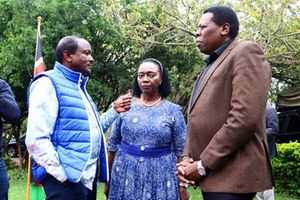
Chepkiit water falls in Nandi County.
| FileNandi
Premium
Nandi County banks on rich, undisturbed cultural tourism sites to boost revenue
Nandi County is banking on its rich historical and cultural heritage to tap domestic and foreign tourism potentials to boost its revenue and supplement financial allocation from the central government.
It has identified community conservancies’ tourism sites among its 10 flagship projects and is collaborating with the Kenya Wildlife Services (KWS) and other government departments in promoting the sub-sector as alternative source of income.
The devolved unit targets sports tourism, cultural exhibitions and diversity of wildlife and plant species to woo local and foreign holidaymakers to generate additional revenue.
Among the historical attraction sites is Koitalel Samoei Museum, located in less than one-acre piece of land along the Kaptumo highway in Nandi-hills Township.
The front view of Koitalel arap Samoei mausoleum in Nandi-Hills town, Nandi County.
The renovated colonial house fitted with red tiles also hosts Mausoleum with the statue of Koitalel Samoei, the Nandi legendry leader.
Standing tall in the compound are two huge fig trees, believed to have grown where Koitale Samoei was buried, more than a century ago.
Adjacent to the mausoleum are two traditional grass-thatched huts –Kot ab gaa, complete with Kalenjin regalia and cultural names bearing specific meanings in harmony with events organized by the local community.
The outer wall of the mausoleum is constructed using hard stones and painted white in implication to the name Koitalel-meaning white stone.
The catacomb has two doors with the main entrance facing North-West towards Mt Elgon from Nandi-Hills, believed to be the entry point of members of the Kalenjin community into the country during the migration period.
The rear door, which faces the southern, part is slightly short and one has to squat when entering in. It is mainly used for ceremonial activities especially during the initiation of boys.
“Koitalel Samoei was shot dead in October 1905 at Ketbarak near the sporting facility after leading a seven-year rebellion against British colonialists,” disclosed Mr Samuel Kosgei, one of the Nandi elders, in an interview.
A documentary by scholars indicate that more than 1,000 Kenyan artefacts are in British Museum, Royal Museum and Pitts River Museum.
“These treasured artefacts of the office of Orgoiyot Koitalel Samoei were recovered through the diligent efforts and guidance of Egyptologist Dr Kipkoech arap Sambu and Doctoral student Kipnyango arap Seroney with the cooperation of Col Richard Meinertzhagen, son of Randle Meinertzhagen on January 23, 2006,” states a plague on the safe where the batons are kept.
Francis Tallam, curator at the Koitalel Samoei Museum in Nandi-Hills town, Nandi County, shows traditional shields and artefacts.
According to Business Daily, Col Richard assassinated Koitalel in 1905 after devising “an evil trick to lure Koitalel. He invited the Nandi leader to a peace parley on “neutral” ground (current Nandi Bears Club) on condition that both parties come unarmed.”
The newspaper says Koitalel had bought into the lie that the British wanted “to discuss surrender terms and guarantees for their safe retreat from Nandi country, Koitalel accepted he ‘collected’ a cache of tribal artifacts for himself and sent Koitalel’s skull to London”.
Chepkiit waterfalls
The gushing Chepkiit waterfalls located along the Eldoret-Kapsabet road, some two kilometres from Eldoret international airport, a sight to behold for bird lovers on a picnic, is another historical site frequented by local and international holidaymakers.
In the local Kalenjin dialect, the word ‘Chepkiit’, means “view from afar” and is a warning according to the locals of how dangerous the falls and its rocky surfaces can be.
The Chepkiit waterfalls are believed to be one of the ‘mercy killing’ sites by members of the Nandi community where elderly people –those above 100 years performed ceremonies before willingly taking away their lives by plunging from the cliff to death.
The waterfall has four different viewpoints where one can get a perspective sight of the river with scenic environment which is home to various species of flora and fauna.
“There are several viewpoints where one can see how water flows quietly before disappearing into rocky waterfalls before relaxing downstream. It is home to different wild animals surrounded by handing rocks and indigenous trees, making it a scenic place to relax,” said Wilson Kipkemboi, a resident.
It costs Sh200 for adults, Sh100 for children and Sh500 for non-Kenyans to visit the scenic waterfalls.
Although it has claimed over 200 lives in the recent past, it remains a beautiful place to visit. The alluring beauty of the waterfall and natural pool conceals the deadly side.
Sheu Morobi cliff
The Sheu Morobi cliff at Kapsimotwo on the outskirts of Nandi-hills town remains one of the cultural attraction sites and untapped tourism magnetism.
The cliff, popularly referred to as the valley of death, is where the elderly would perform rituals before committing suicide.
The Sheu Morobi cliff at Kapsimotwo on the outskirts of Nandi-hills town.
“It is believed that those who died at the cliff directly went to God the creator in heaven and were considered heroes,” said Samuel Ngetich, one of the elders.
The elderly persons, who declined to be taken to Sheu Morobi cliff, were termed as cowards and outcasts and once they died, their spirits would cause misfortunes.
The Sheu Morobi cliff ceremonies used to take place at dawn at around 4am. Thereafter, the elders were entertained with the best food, meat and traditional wine.
The age sets of Nandi people who went into Shehu Morobi cliff include Nyongi, Kaplelach, Kipnyege, Sawe, Maina and Kipkoimet.





